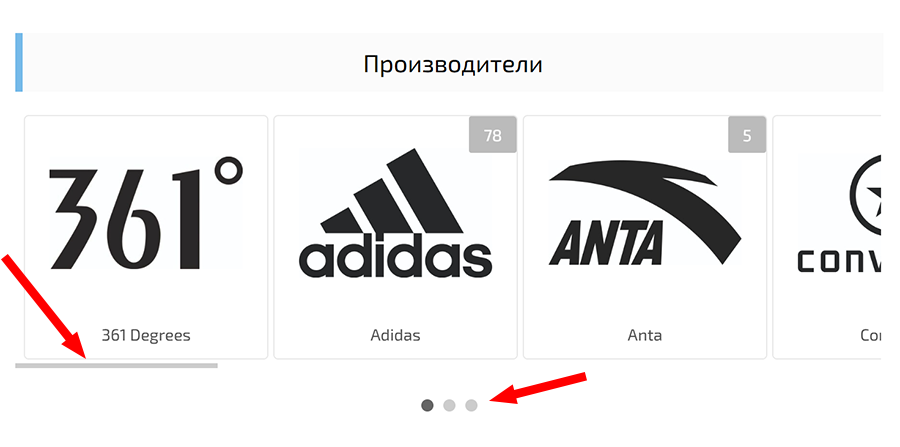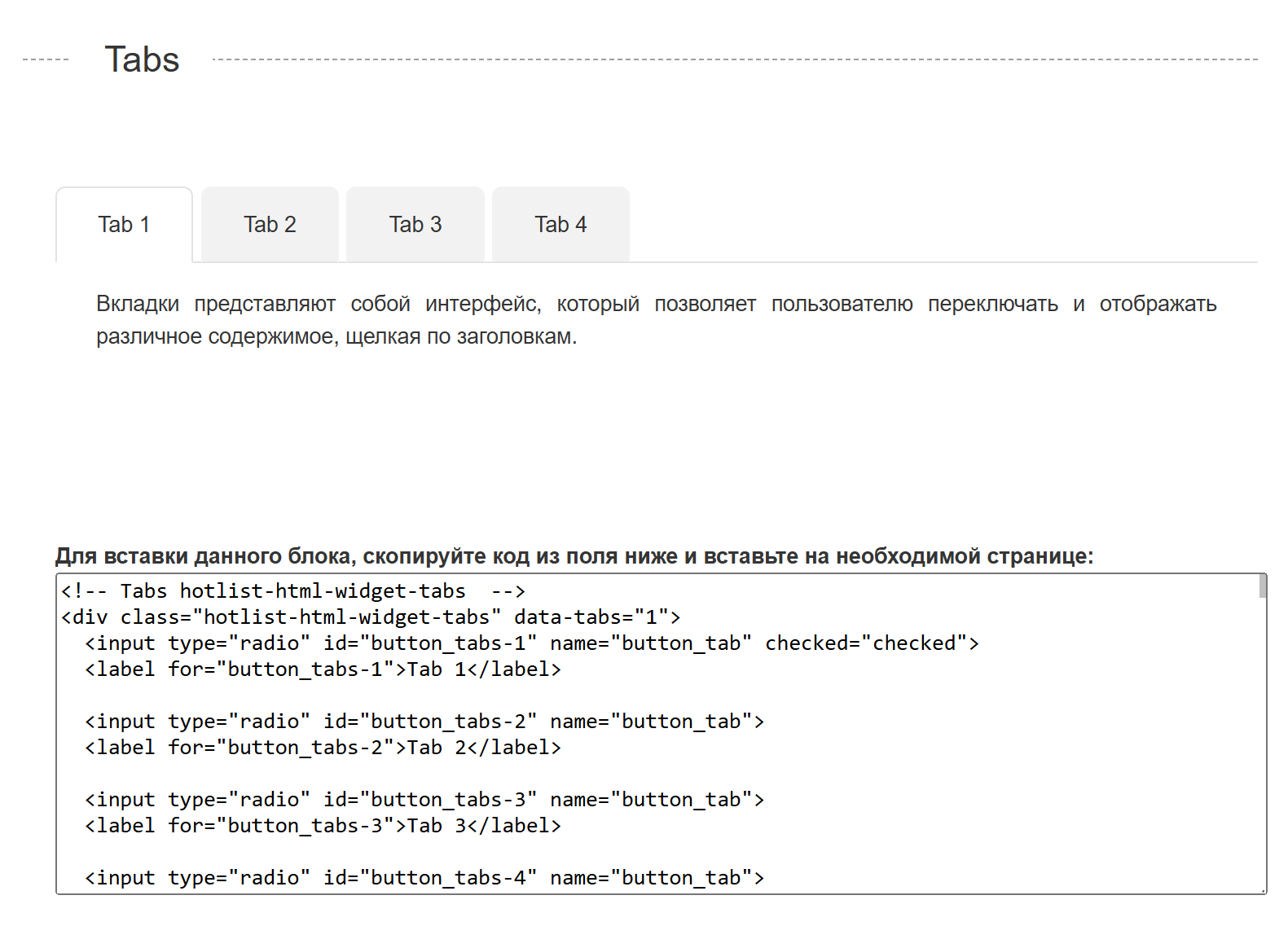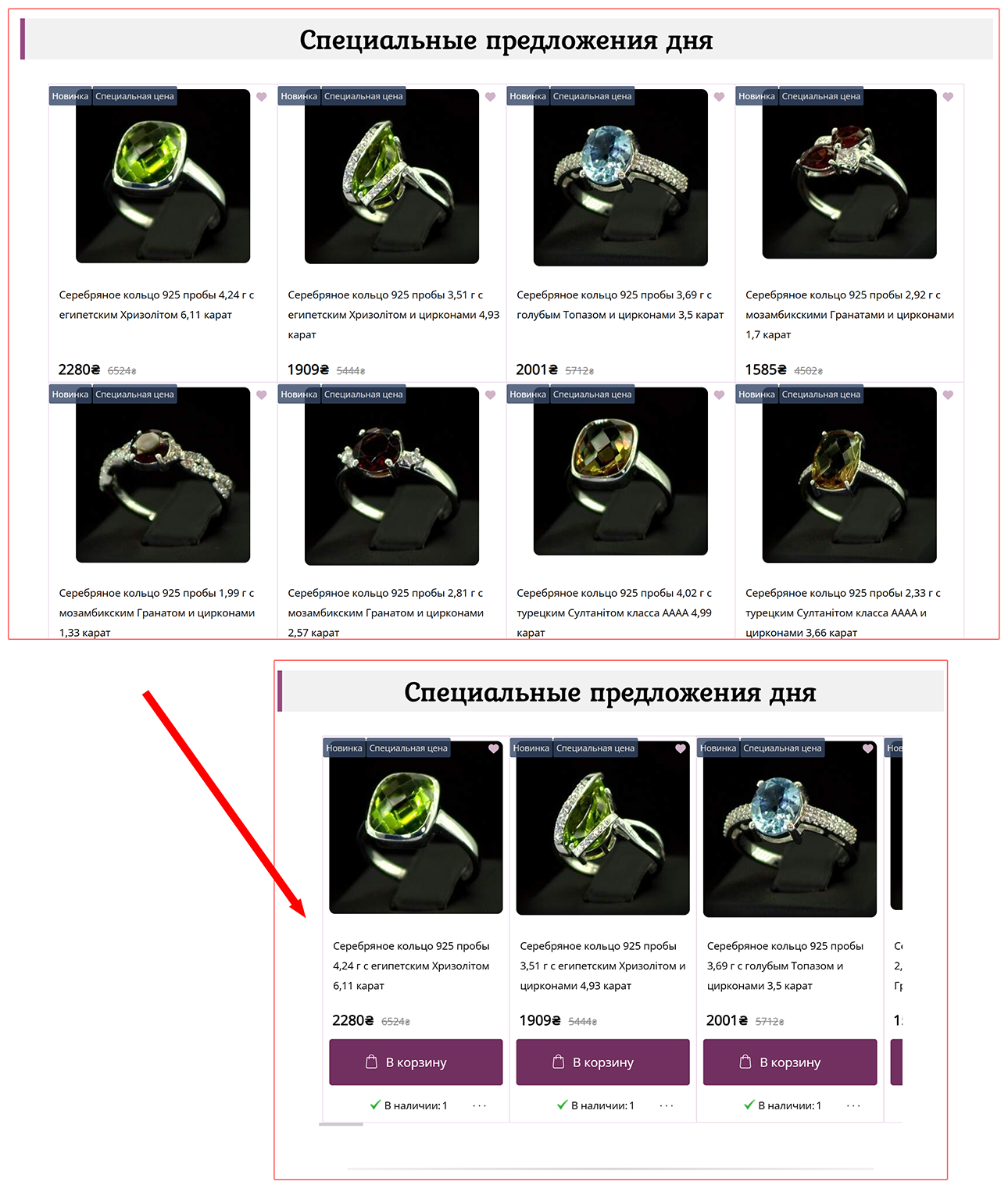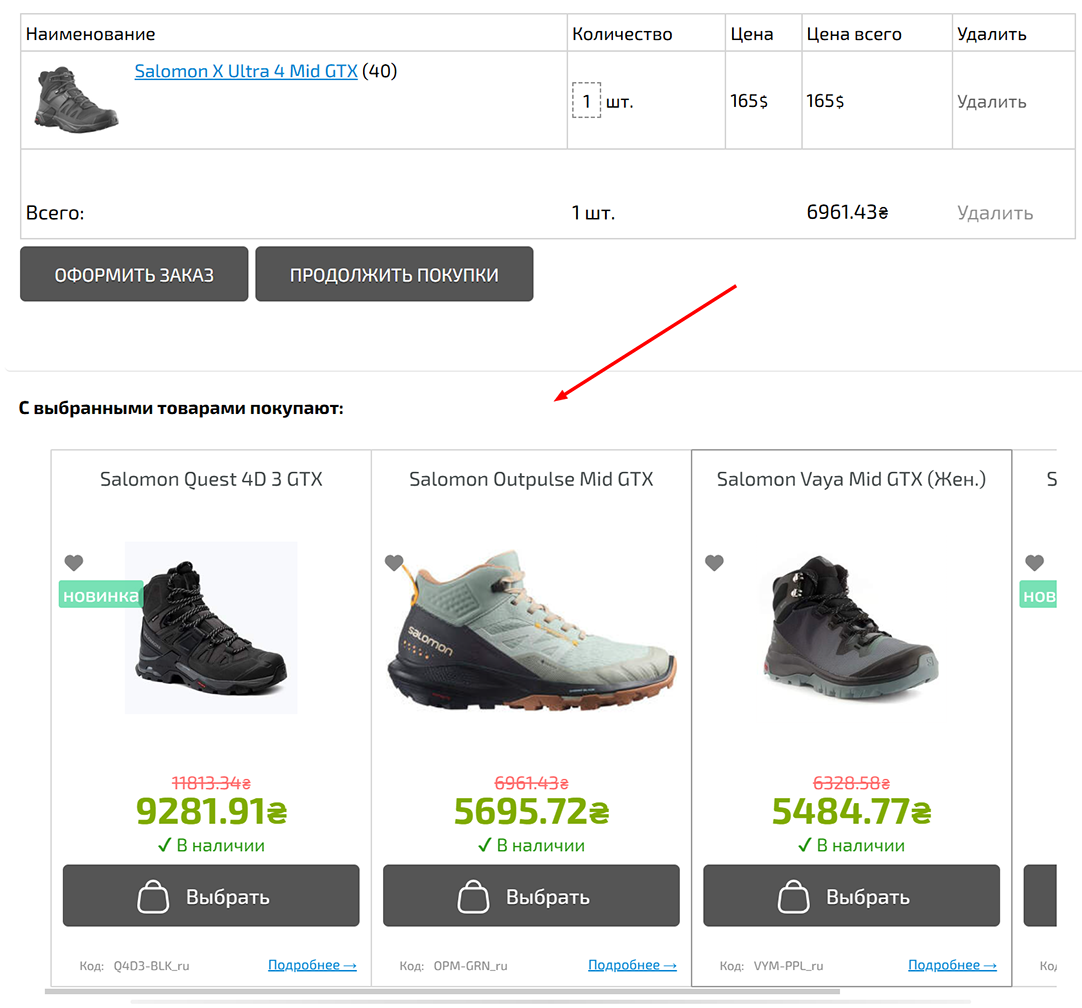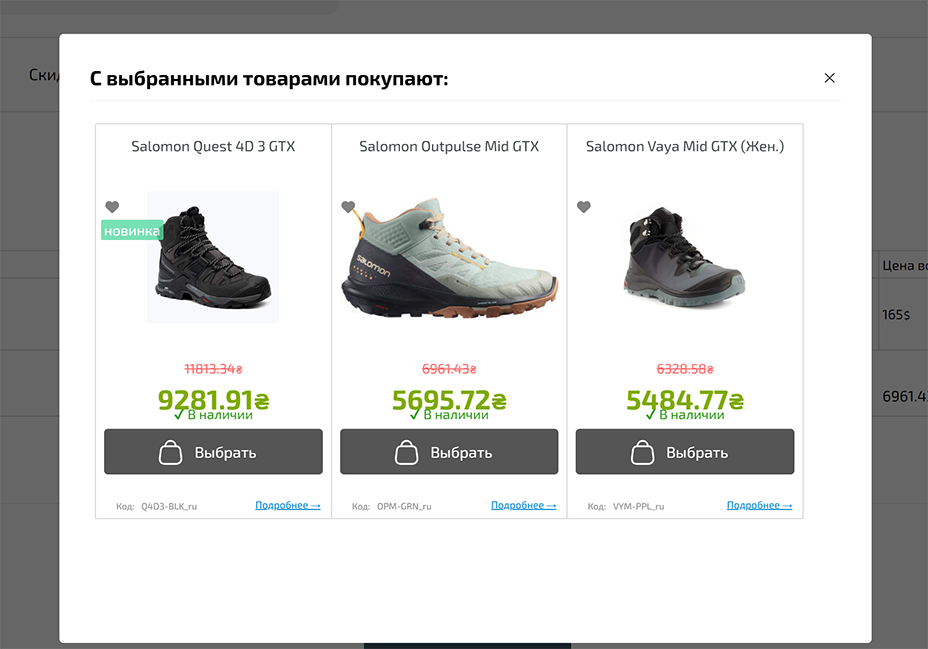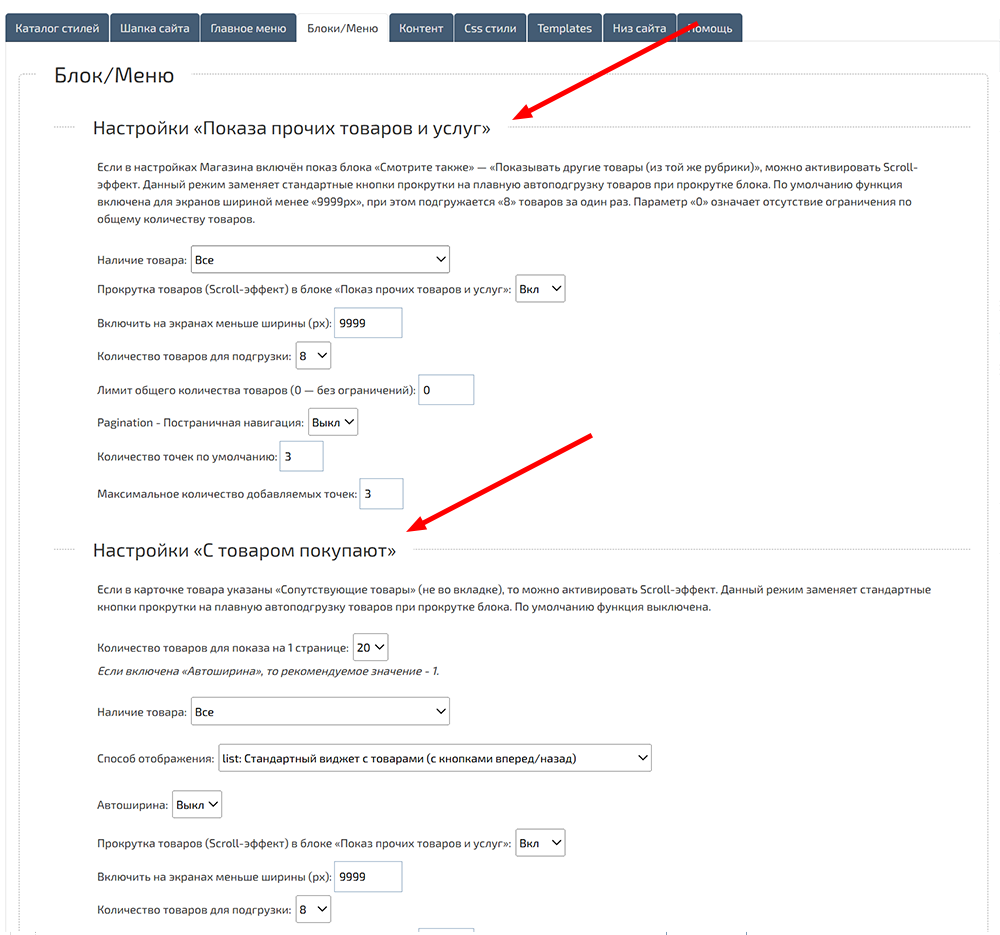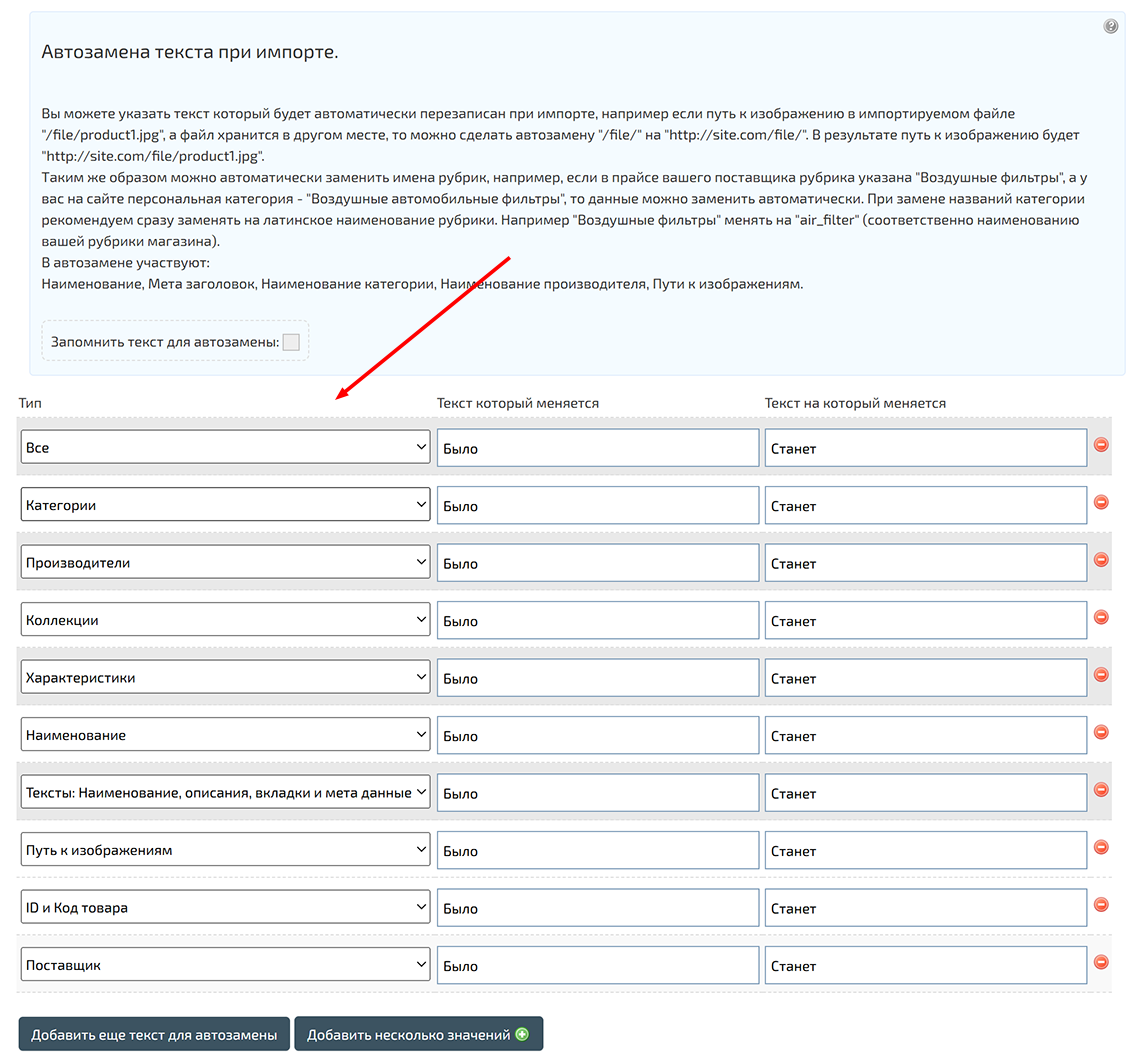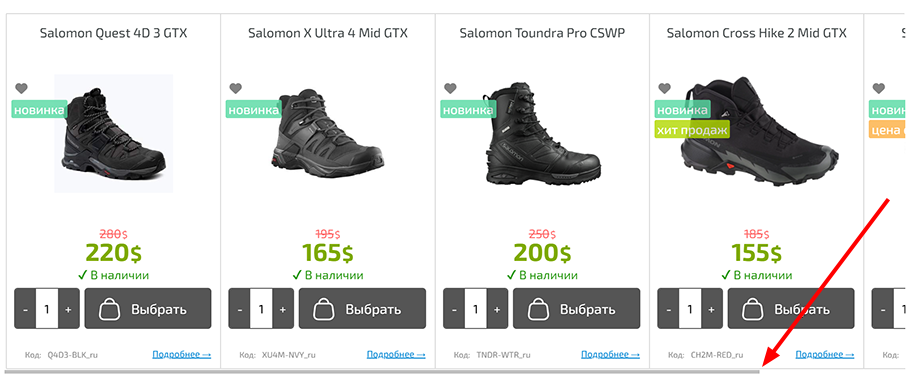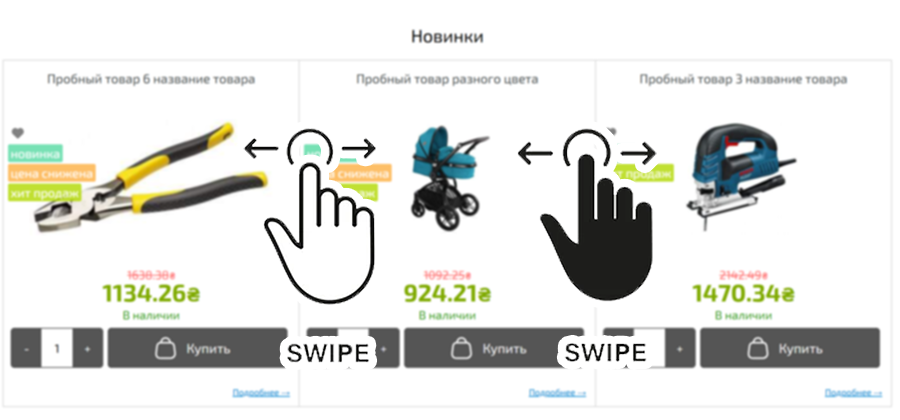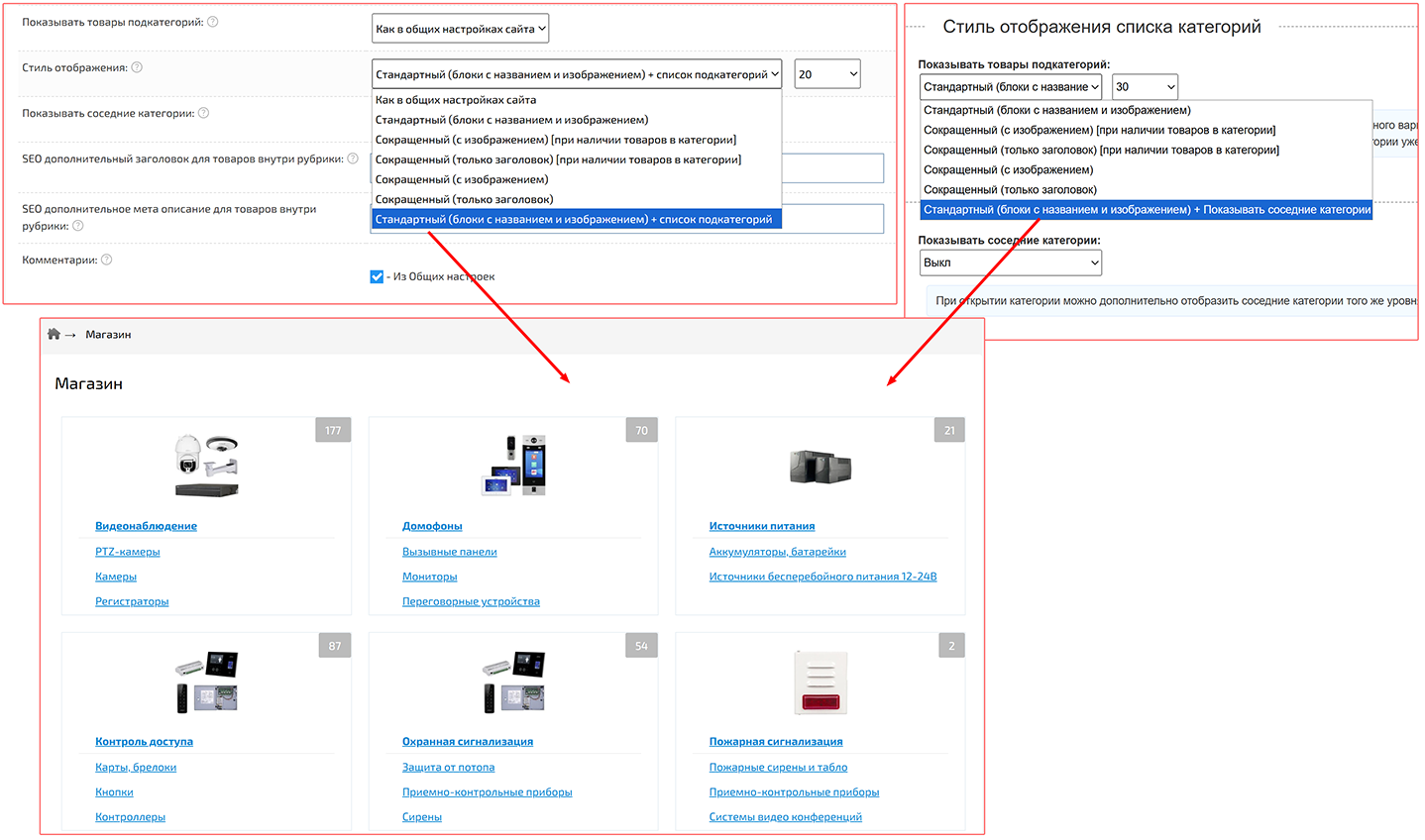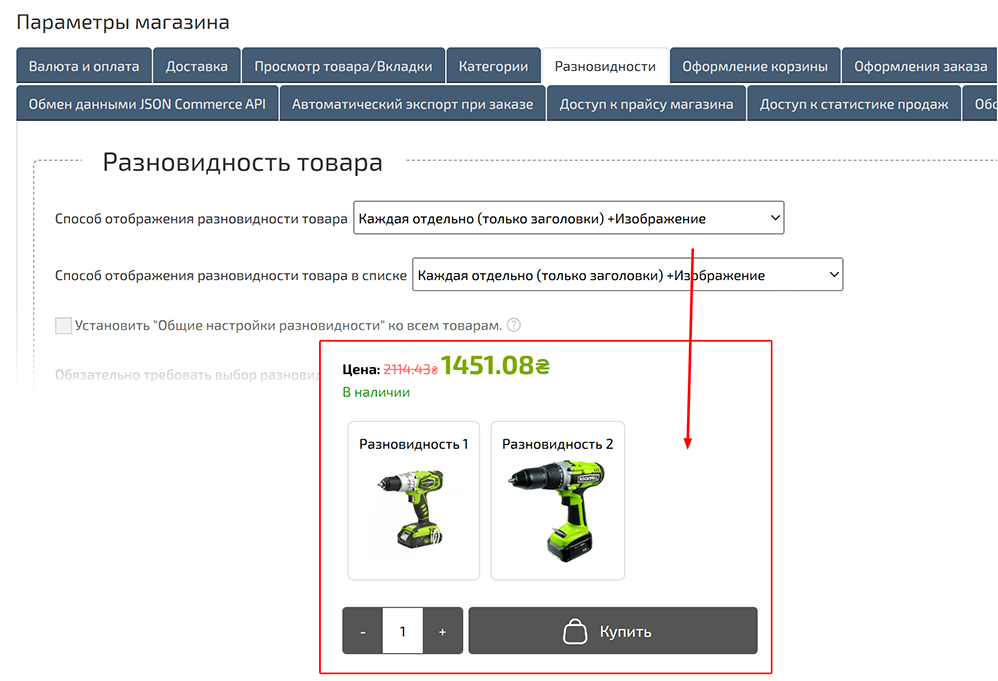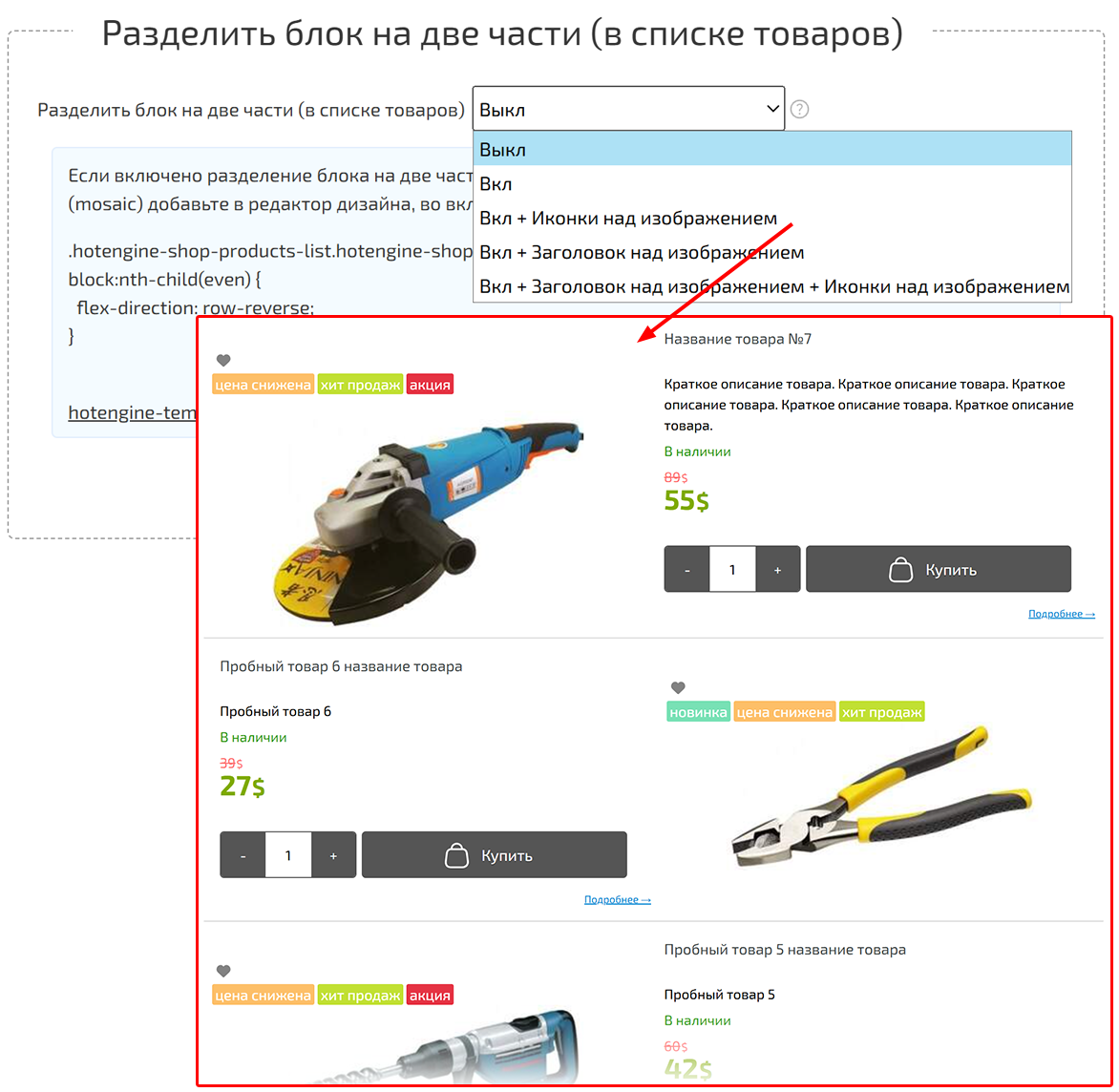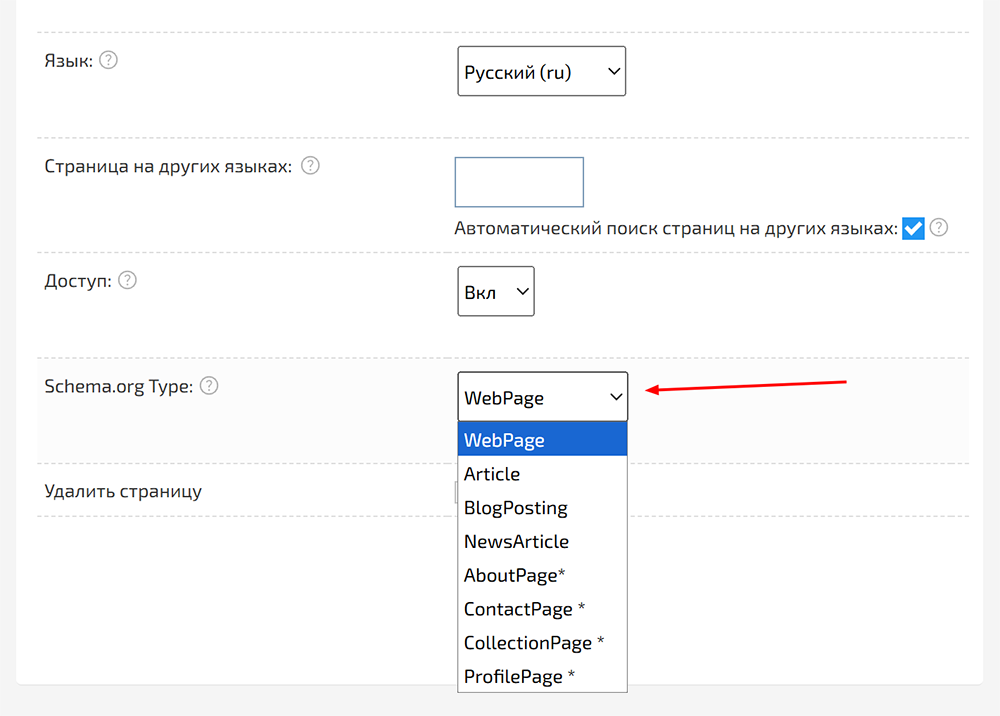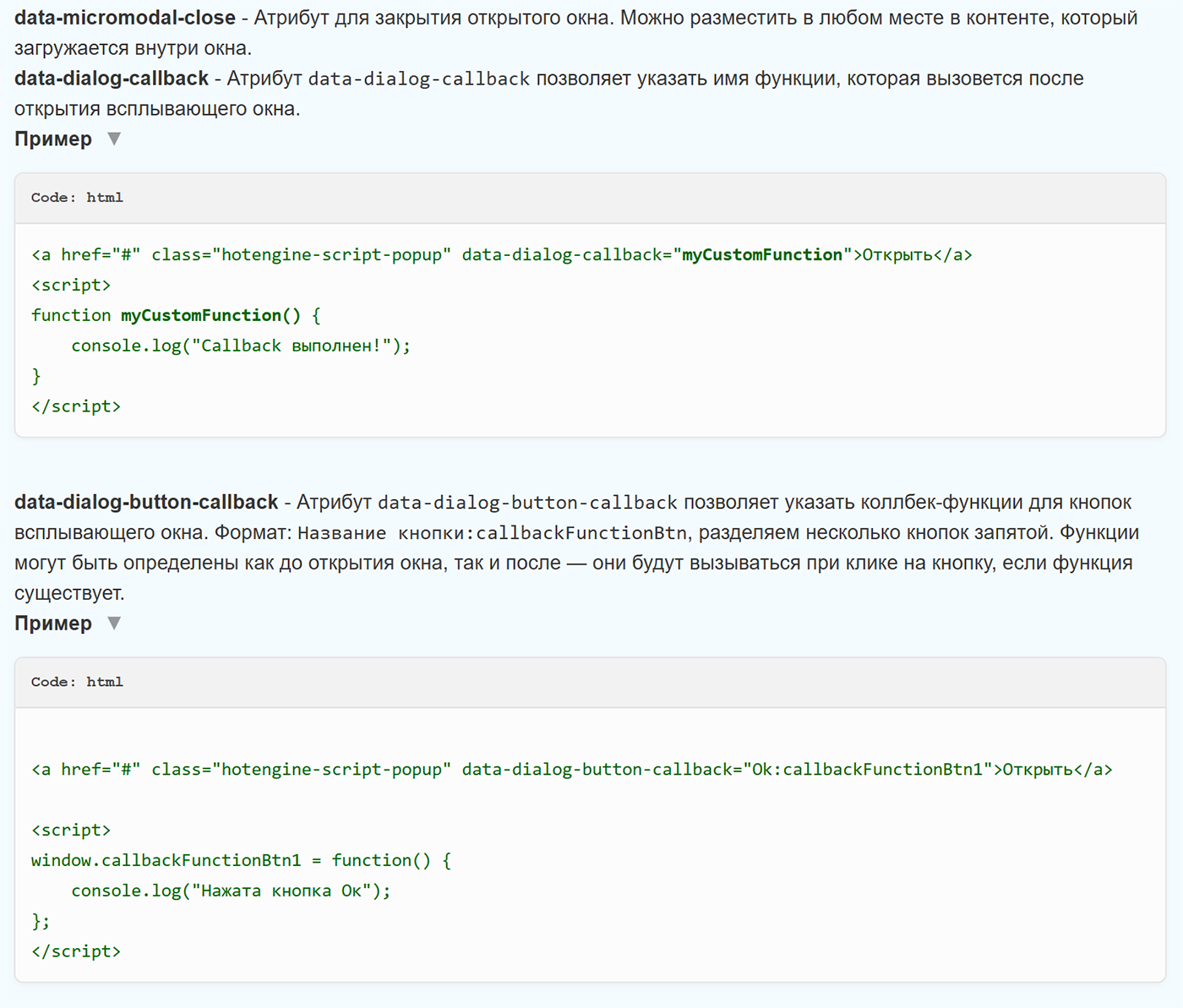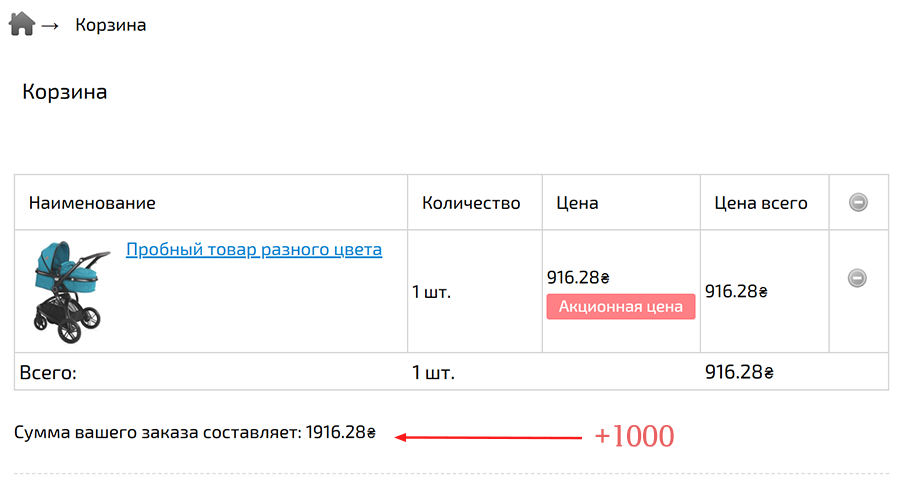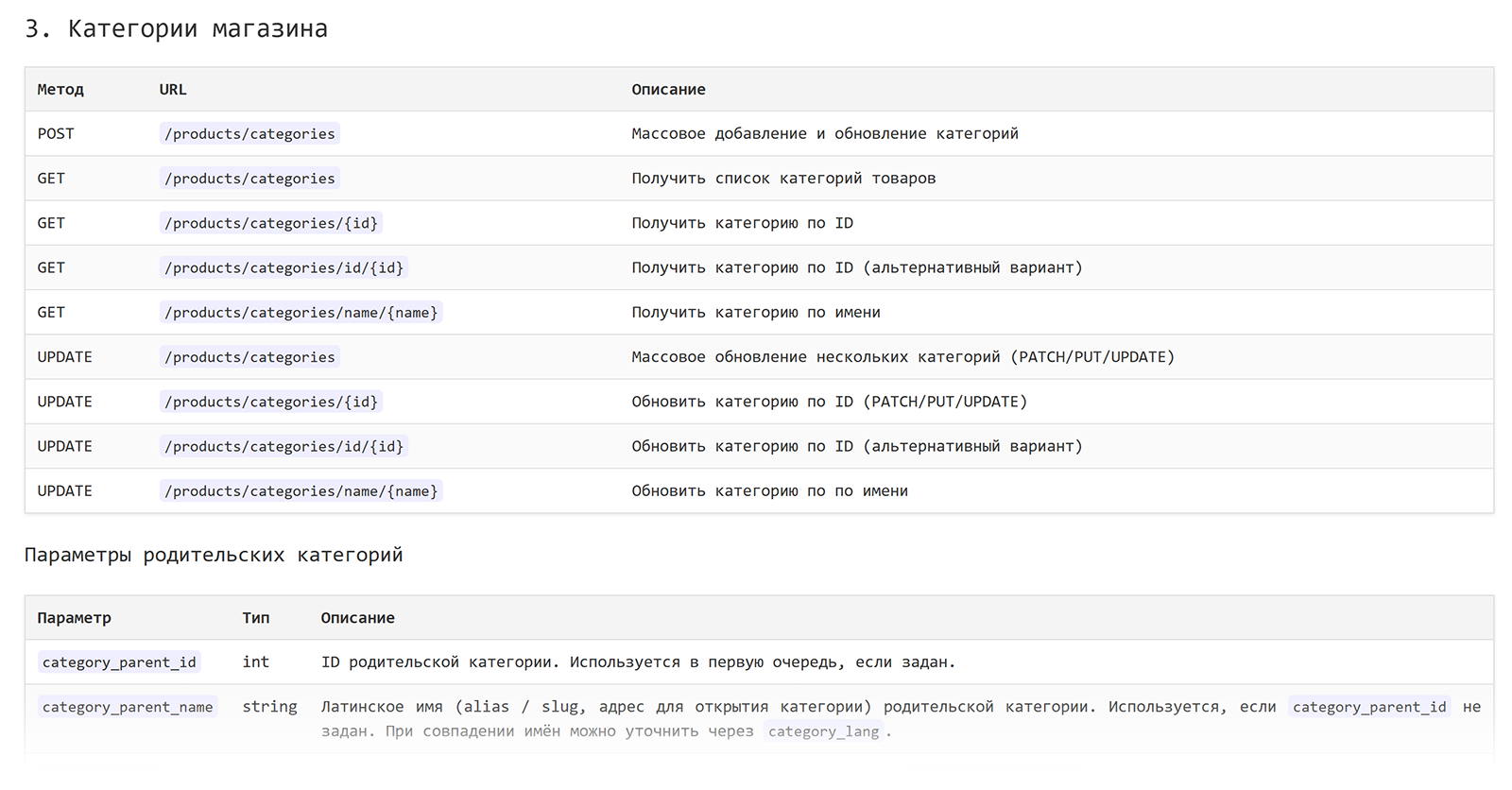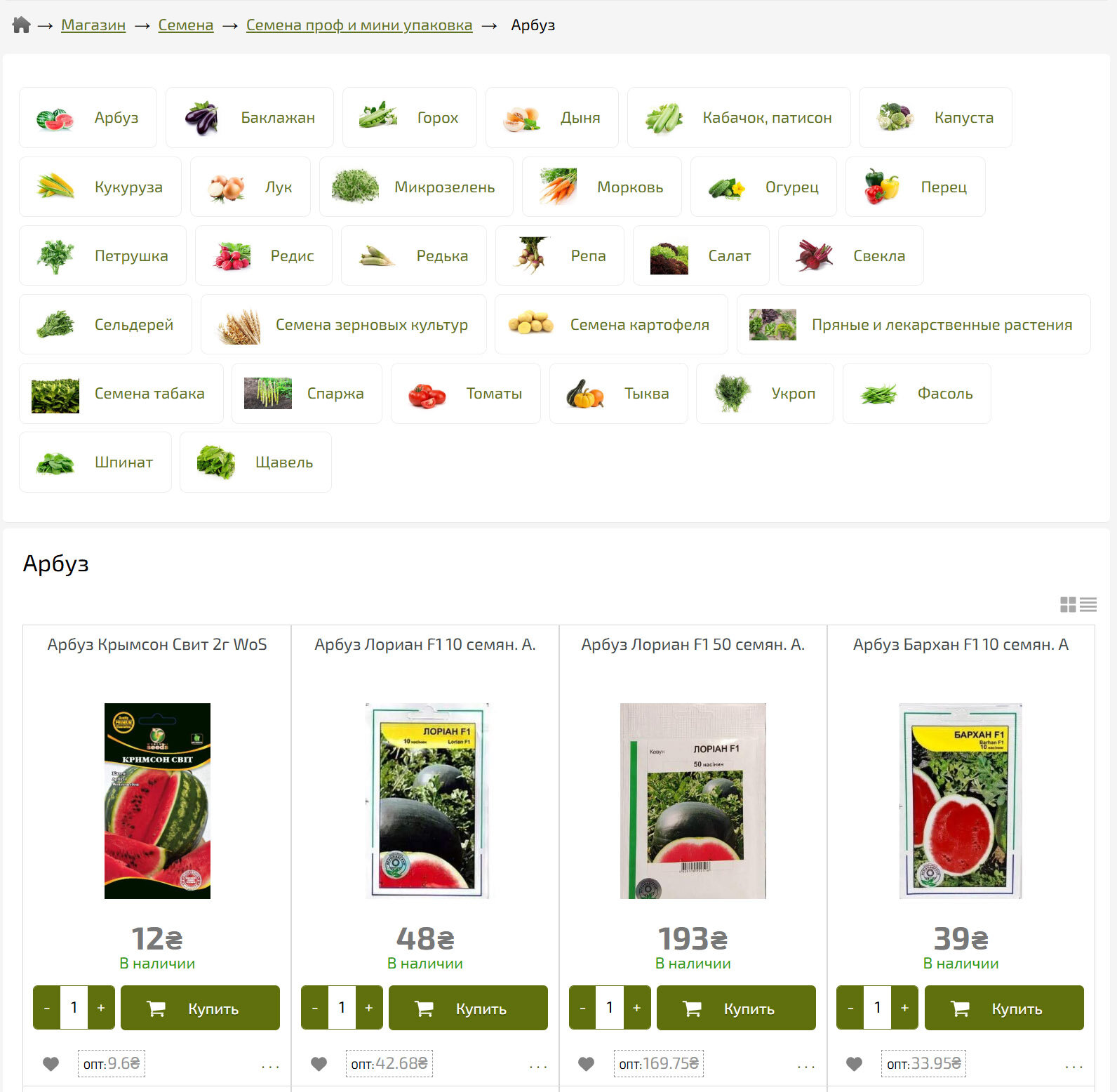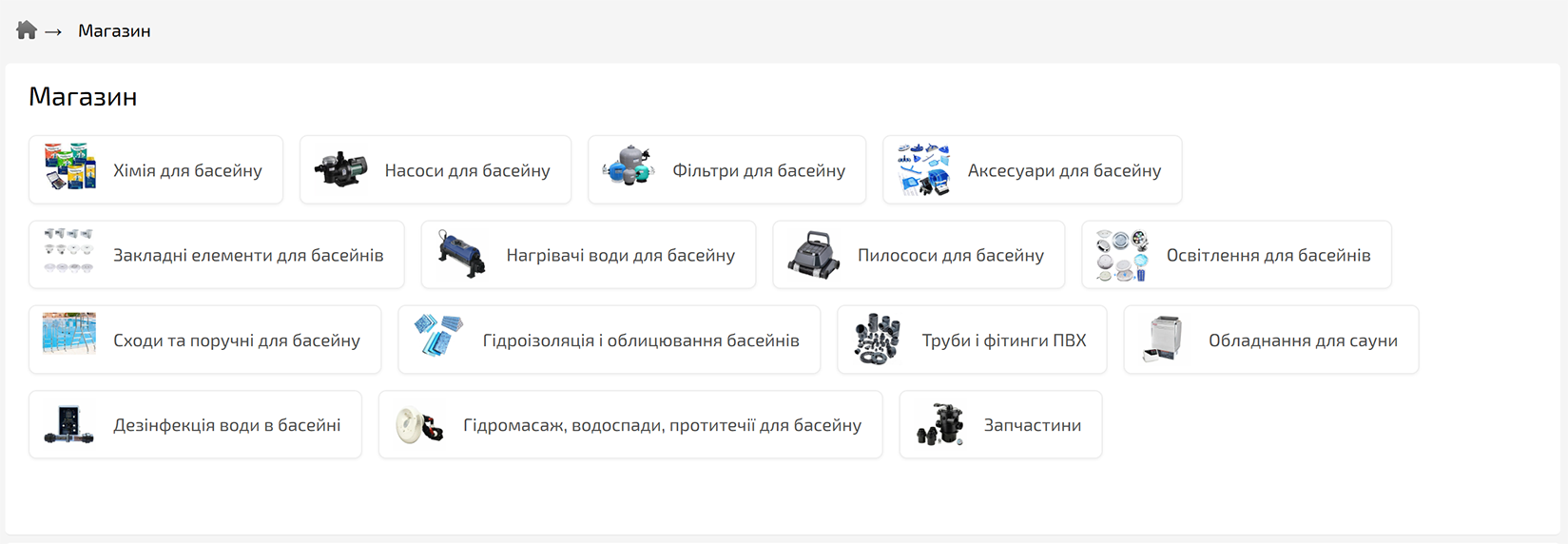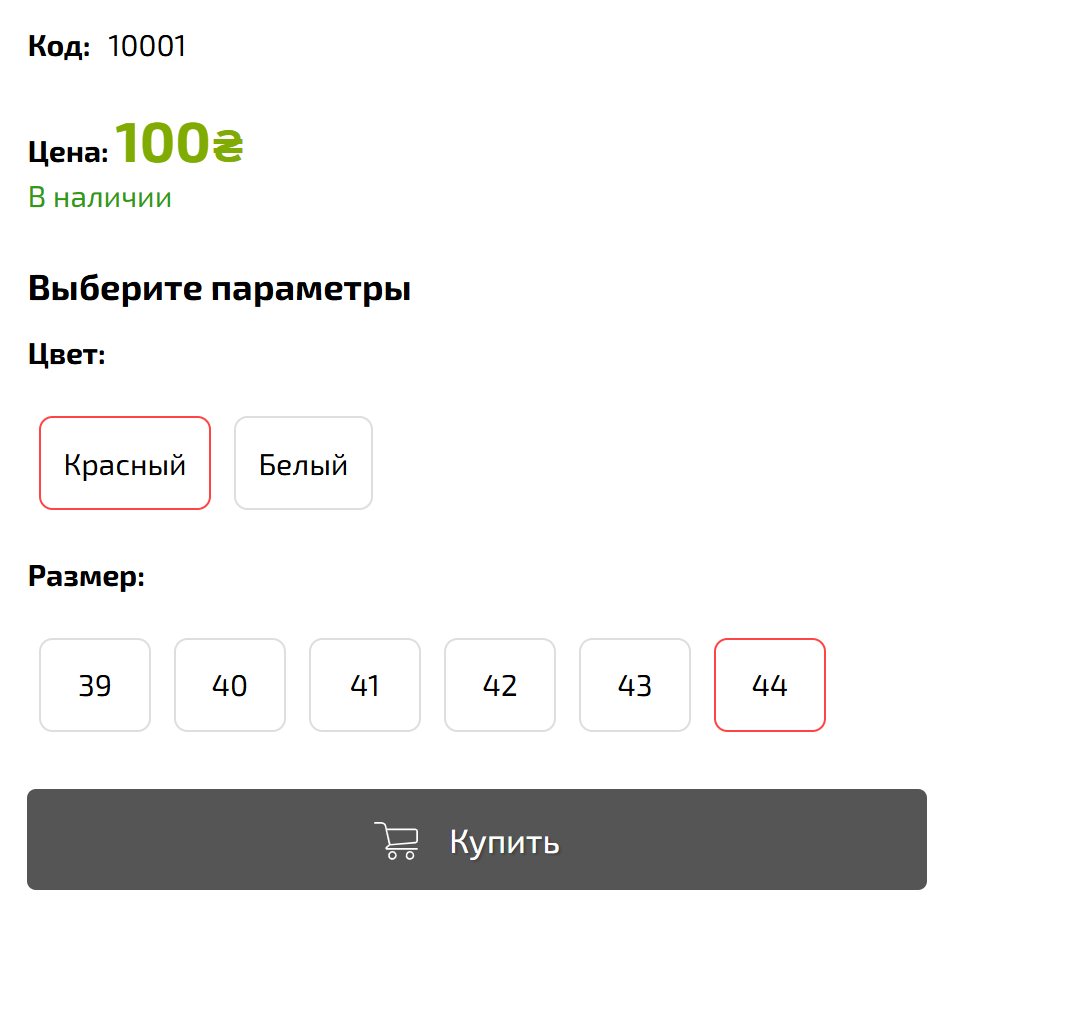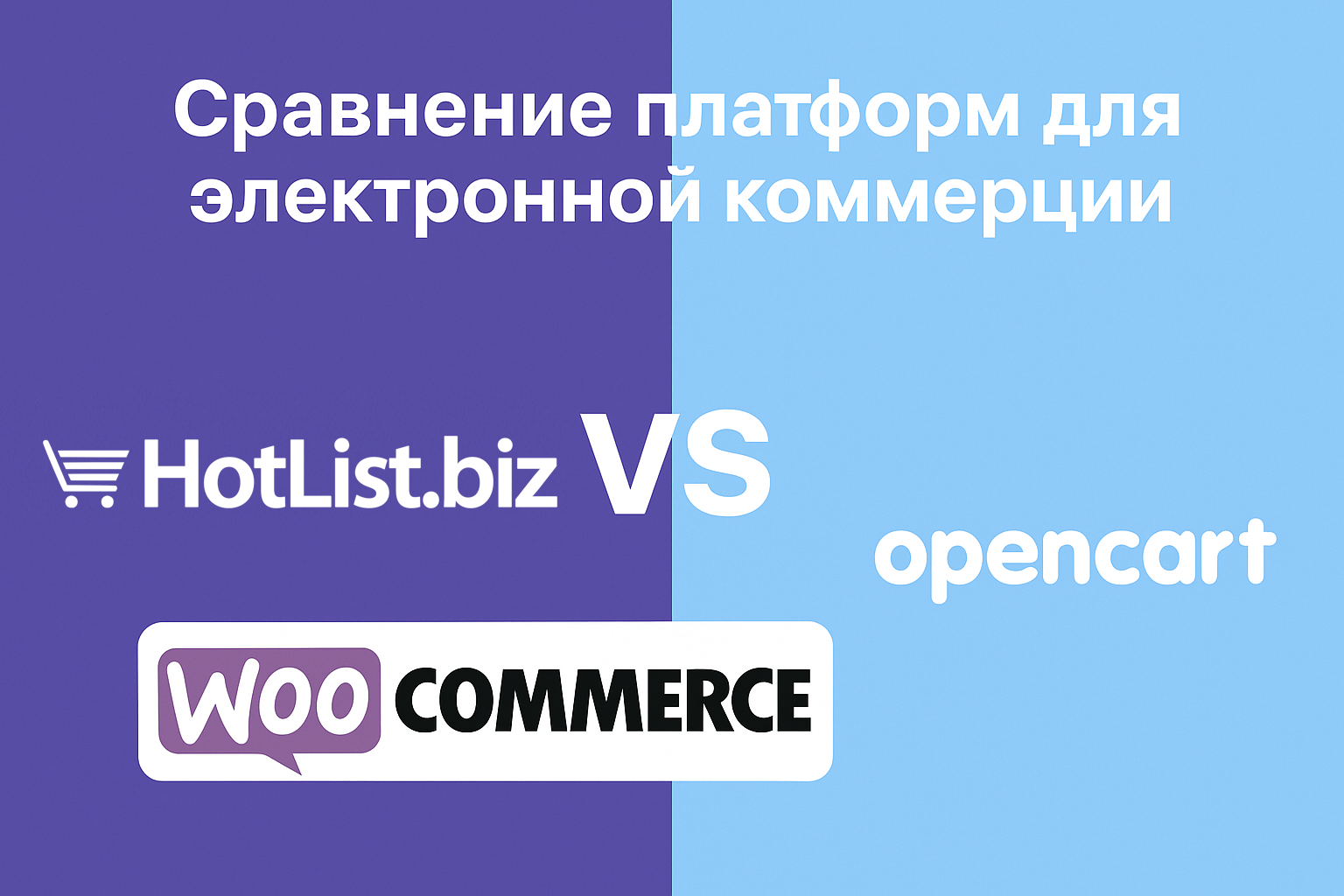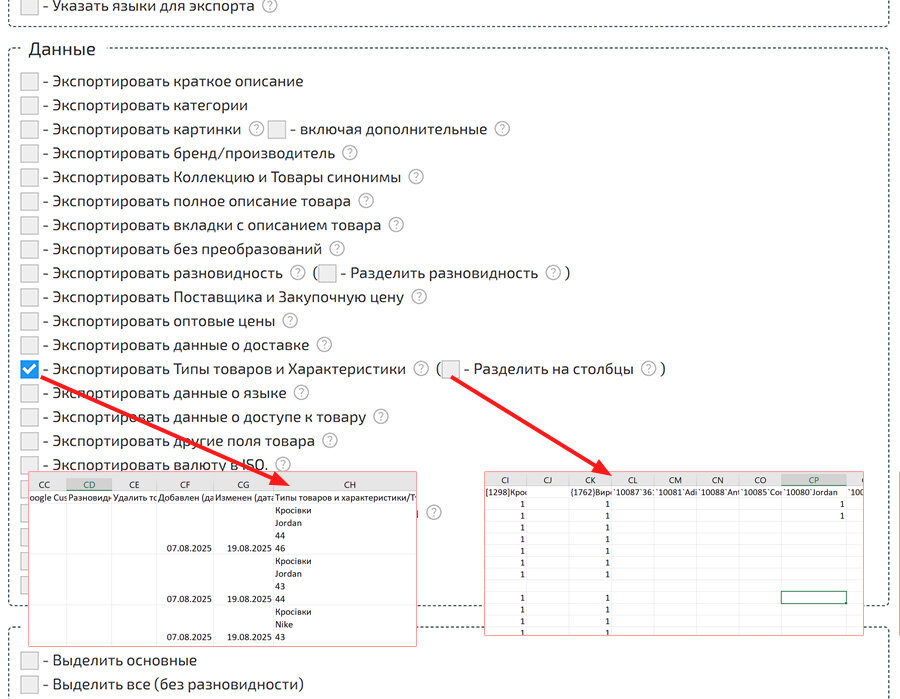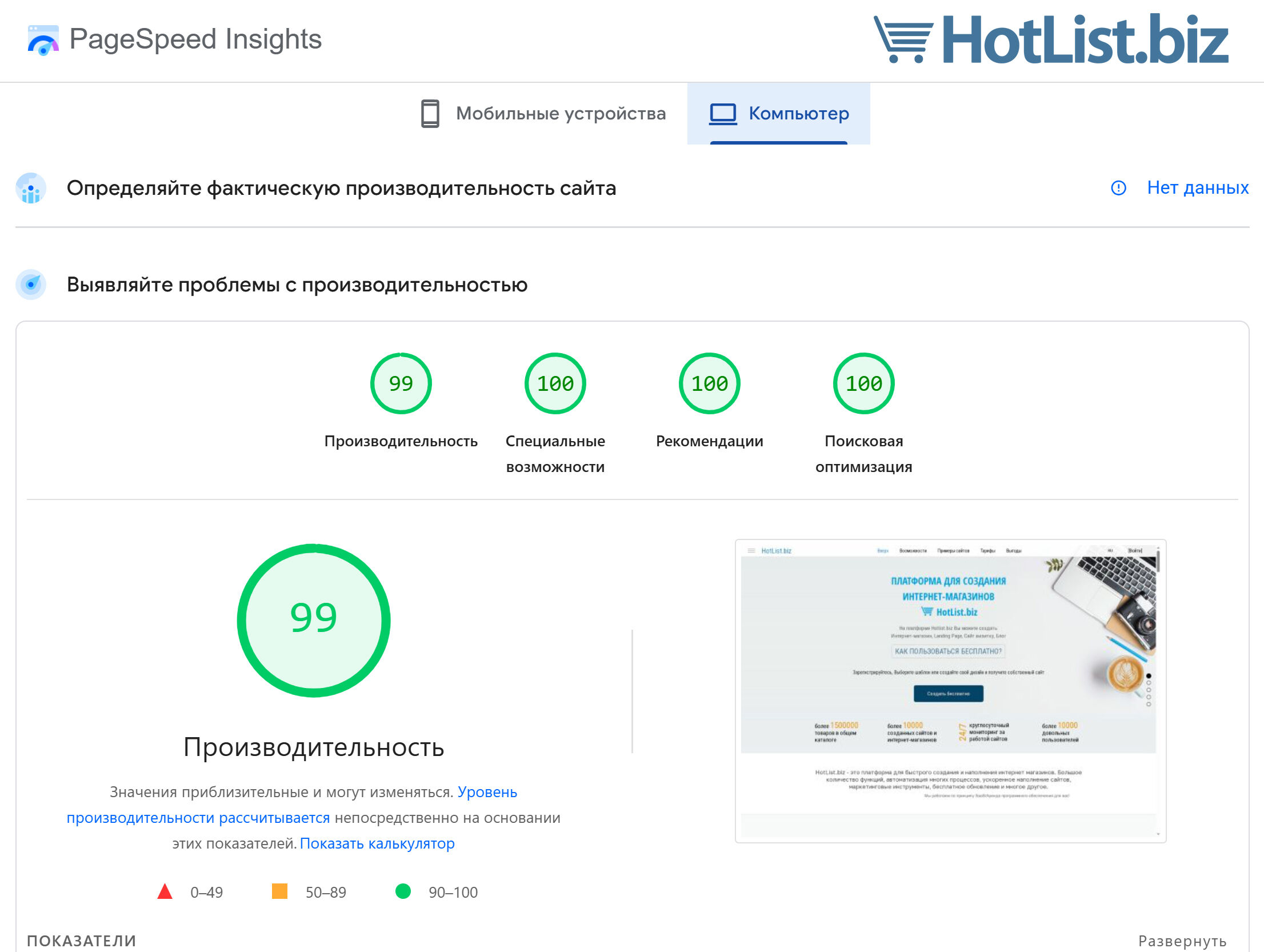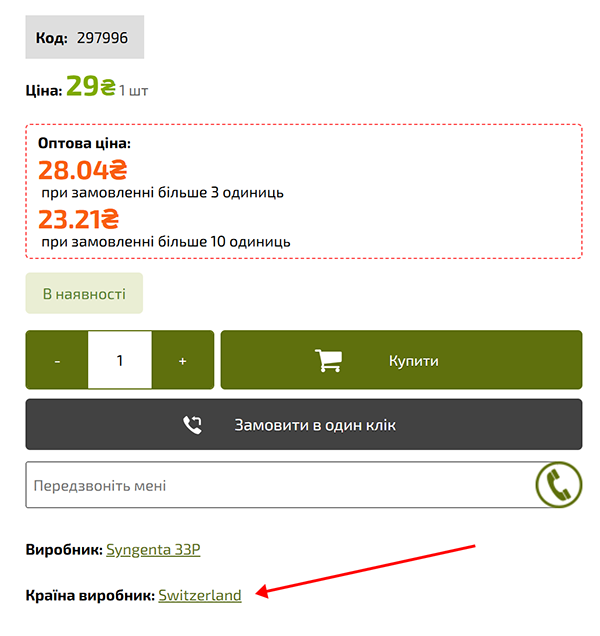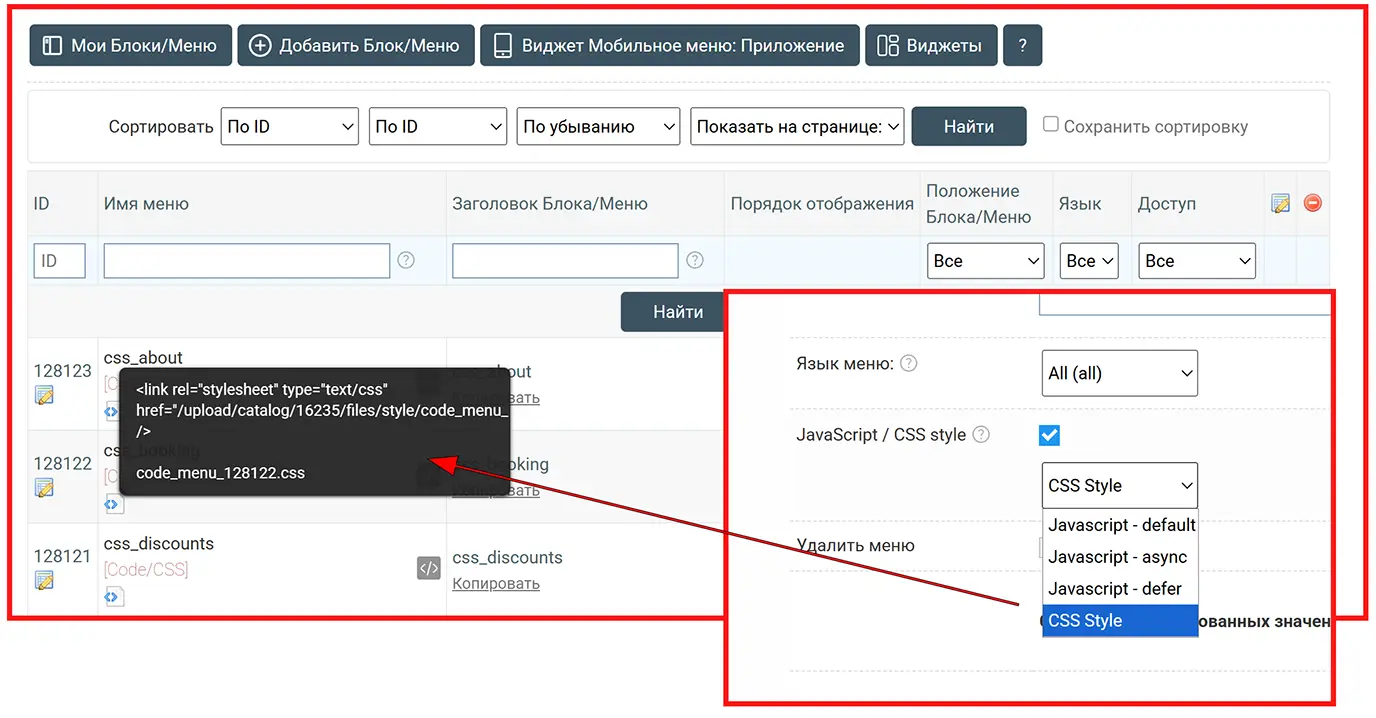Updates and News
Scroll mode added to Categories and Producers widget
The platform now features a new horizontal scroll mode for the "Categories" and "Producers" widgets. The mode is activated automatically if the widget has the :scroll-9999 parameter, which sets the maximum screen width for enabling the scroll (if the actual screen width is smaller, the mode is activated).
If the screen width is smaller than specified:
- The widget automatically switches to horizontal scroll mode;
- Block widths for categories/producers are calculated including padding and margin across all container levels;
- Drag-scroll works on desktop;
- If the second argument is specified in the parameter (:scroll-9999x3), pagination with the specified number of dots is enabled (3 in this example).
If the screen width is larger than specified:
- Scroll mode is completely disabled;
- The layout returns to standard display;
- Pagination (dots) is removed.
How to enable Scroll mode
- In the categories or producers widget generator, specify the parameter:
:scroll-9999— the screen width below which scrolling is enabled. - If needed, add the number of pagination dots using the second parameter:
:scroll-9999x3— the number "3" enables pagination with three dots. - The script activates automatically on page load.
HTML Example (generated automatically)
<div class="hotengine-categories-list"
data-scroll-width="9999"
data-scroll-pagination="3">
...
</div>
After that, scrolling and pagination work automatically depending on the screen width and parameters set in the widget.
Additional Spam Protection Added
A new level of spam protection has been implemented in the message sending system. Now, verification is performed not only by detecting links, banned words, or phrases, but also by comparing the text with previously sent messages.
If the system detects repeated or fully identical messages, they are automatically marked as spam. This significantly improves filtering accuracy and prevents mass duplicate mailings.
Added HTML Widget with Tabs (fully HTML without JavaScript)
A new HTML Widget with Tabs has been added on the Hotlist.biz platform. This widget works without additional scripts and allows organizing multiple tabs inside a block.
Each tab can interact with product widgets, providing convenient viewing and navigation.
Product Widget Update: Dynamic «append» Mode
In the Product Widget, the :append mode (adding products to the end of the list when clicking «Show More») now has a new feature: the product block can automatically change its display mode depending on the screen width.
Specifically:
- On mobile devices and smaller screens, the block can switch to scroll or swipe mode with limited width and product scrolling.
- On larger screens, the standard
:appendmode continues to work, adding products to the end of the list.
The :append mode is activated by parameters, for example :append-900x9999, where:
- 900 — minimum screen width (in pixels) to activate the function;
- 9999 — maximum screen width (optional) until which the function works.
If only the first parameter is specified, e.g., :append-900, the function will be active for screens 900px wide and above.
Now the append mode is more flexible and mobile-friendly, keeping the convenience of adding products and the visual layout of the widget.
Added functional block «Frequently Bought Together»
A new functional block — «Frequently Bought Together» — has been added to the system. It displays a list of related products that are most often purchased together with the selected items.
The products in this block are generated based on the contents of the shopping cart and the data from each product’s field «Related products».
The block is built on the «Products Widgets» module, which allows you to flexibly configure display parameters and adapt it to any part of your website.
- Where to display: any section of the site — cart, product page, footer, sidebar, etc.
- Display control: number and order of products, category and stock filters.
- Display format: list, gallery, slider, or slider with scroll effect.
- Automation: automatic detection of related products based on catalog data.
It is recommended to use this block on the cart page — it’s a simple and effective way to suggest relevant add-on items to customers and increase the average order value.
Installation: go to «Blocks/Menu» → «Add Blocks/Menu» → «Functional menu» → «Products: Related products»
New JavaScript for Dynamic Creation of the “Product Widget”
A new JavaScript has been added to Hotlist.biz that allows you to create “Product Widgets” dynamically — directly on the page, without manually inserting a standard widget.
You can now load product lists on the fly, apply display parameters, adjust styles, place blocks in specific areas of the page or in popup windows, and enhance them with interactive features.
Script file: /templates/scripts/hotengine-scripts-additional/hotengine-shop-products-list-generated.js
Detailed usage guide: https://hotlist.biz/ru/scripts_guide.html#faq_shop_catalog_page_getproducts_list
With this script, you can quickly generate a dynamic display of products using the “Product Widget” parameters — setting styles, limits, category filters, and other settings.
Examples of design and visual options can be found here: https://blog.hotlist.biz/en/blog/instructions_en/15055.htm
The script simulates the operation of the standard “Product Widget”, ensuring full compatibility with Hotlist events and mechanisms — including product scrolling, styling, and display modes.
Example #1 — Related Products in Cart (“Frequently Bought Together”)
Using this script, you can create a “Frequently Bought Together” block that automatically loads related products connected to the items currently in the customer's cart. This is an effective tool for increasing the average order value and customer engagement.Guide and setup example:
https://hotlist.biz/ru/scripts_guide.html#faq_shop_catalog_page_cart_bought_with
The block can be loaded either in a **popup window** or **within the page content**, allowing you to specify **after which element** or **instead of which element** the product list should appear.
Example #2 — Related Products after Adding to Cart
An additional example demonstrates integration with the **Callback function triggered after adding a product to the cart**: https://hotlist.biz/ru/scripts_guide.html#faq_callback_hotengine_cart_plus_afterWhen the `hotengine_cart_plus_after` event occurs (product added to cart), a popup window automatically opens showing related products — using the same script hotengine-shop-products-list-generated.js.
This approach allows combining different user interaction scenarios — showing relevant products exactly when the customer is ready to buy, enhancing the store’s effectiveness.
Hotlist.biz platform adds management of additional product blocks
The system now offers full management of additional product blocks, allowing flexible configuration of their appearance and behavior directly from the admin panel.
Block «Frequently bought with» — Related products
New display parameters have been added for the related products block. You can now choose one of the following formats:
- Standard list — with the option to load more products by clicking the «Показать ещё» button.
- Standard slider — classic product scrolling format with navigation arrows.
- Slider with swipe effect — modern way to scroll through products using a mouse or touch gestures.
- Scroll mode — a new convenient horizontal scroll format with product loading inside the block without changing its width (products in a single row).
Additionally, for all modes except the first (Standard list with button), you can enable the «Автоширина» option — products automatically adjust to the available space. You can also specify the number of products for initial display (default — 20).
Bottom block — other products from the category
The bottom block now supports flexible display effect configuration. All modes can be enabled except for the Standard list with the «Показать ещё» button. It is also possible to activate the scroll effect.
When using the scroll mode, you can enable pagination, where you can define:
- Initial number of dots — the number of pages displayed when the block loads.
- Number of additional dots — scroll dots that appear as the user navigates forward through products. For example, if the user scrolls forward 6 times and products are available, 6 navigation dots will appear.
The new settings allow you to create a modern, dynamic, and user-friendly storefront interface, increasing engagement and conversion rates.
New Feature in Product Widget — Pagination
We are excited to announce a new feature in the product display widget — pagination. Now you can manage the display of product blocks using dots that indicate the current page and allow quick navigation between pages.
How it works
- If pagination is not specified, the dots are disabled and the block works as before.
- If one or two numbers separated by a comma are specified, pagination is enabled:
- The first number — default number of dots;
- The second number — maximum number of dots added when loading more products.
Example parameter
:scroll-768x8x64x3,3
- 768 — minimum screen width at which the function is activated;
- 8 — number of products loaded per scroll;
- 64 — maximum total number of products (0 — unlimited);
- 3 — default number of pagination dots;
- 3 — maximum number of dots added when loading more products (can be left empty if not needed).
Usage
- The parameter can be set when creating the product widget.
- Pagination works only in
scrollmode. - If
:appendor:carouselparameters are specified, pagination will not be active. - On mobile devices, the feature conveniently mimics Swipe and does not take extra space.
Updated Method for Auto-Replacement During Product Import
On Hotlist.biz, the auto-replacement mechanism during product import has been updated. Now you can manage data replacement more flexibly during import.
What's new:
- Fields can be separated by type for replacement.
- Support for multiple types of auto-replacement simultaneously.
- Easy integration with existing import settings.
- Bulk adding of values (can paste from Excel).
- Updated interface for managing replacements in the product table.
Benefits:
- Reduces time required to prepare import data.
- Fewer errors during mass product updates.
- Flexible auto-replacement setup for different categories, manufacturers, and attributes.
The update is now available to all users. To use the new features, simply go to the product import section and set up auto-replacement according to the new rules.
Extended demonstration of the “Product Widget”
We are pleased to announce that the extended demonstration of the “Product Widget” is now available! You can explore the widget’s features in detail, view different product display options, and customize the block to suit your needs.
Check out the demonstration at the link: Extended demonstration of the “Product Widget”
Swipe effect added for product and article blocks (scroll block with auto-loading of next products).
Scroll function added to Product Widget
We present a updated way to display products in store widgets — now the standard product list block can be replaced with a scroll block with swipe and auto-loading of next products.
How the new feature works:
- The standard product block is replaced with a scroll block (Swipe imitation for mobile devices and convenient mouse scroll on desktop).
- When reaching the second-to-last product, the next products are automatically loaded without reloading the page.
- The feature saves screen space and makes product browsing smoother and more convenient.
Block configuration:
The product block is replaced when the specified parameters are set, for example: :scroll-768x8x64, where:
- 768 — minimum screen width for the feature to activate;
- 8 — number of products loaded per fetch;
- 64 — maximum number of products in the block (0 — unlimited).
Recommendations for use:
- Enable
:auto_width— auto-width, so the number of displayed cards adjusts automatically to the block width. - Enable
:swipe— Swipe effect for convenient scrolling by finger or mouse. - Enable
:scroll-768x8x64— replace standard display with scroll block on mobile devices to save space and remove navigation buttons. - Enable
:lazy-0— accelerated image loading for faster page performance.
User benefits:
- Saves space on mobile devices.
- Smooth product scrolling with auto-loading.
- Ability to automatically adjust the number of cards to screen width.
- Compatibility with existing widget styles and scripts.
With this new feature, your widgets will become even more convenient and modern, and browsing products will be more interactive and faster.
Swipe effect added for product and article blocks.
Now in our product widgets there is a swipe effect, activated using the code :touch in the block settings.
- Swipe products with your finger on mobile devices or with the mouse on desktop.
- Smooth scrolling animation without “sticking” or accidental triggers.
- Respects cart buttons, favorites, spinners, and links — swipe does not interfere with their use.
- Text selection and hover effects are disabled during swipe for better user experience.
Example:
templatedemo437544.hotlist.bizNew Setting: Display List of Child Subcategories
A new feature has been added to the Hotlist.biz platform — you can now control the display of child subcategories and specify the number of subcategories displayed.
This setting can be set:
- 📂 In the "General Settings" tab "Shop → Categories";
- 🛠️ Individually for each store category.
Now you can easily control how many subcategories to show to users, making your store interface more user-friendly and visually appealing.
Example: if you specify 10, only 10 child subcategories will be shown on the category page, even if there are more.
Use this setting to optimize category display. and improve your store navigation! 🌟
New Feature: Split product block into two parts (when viewing product list).
We added the ability to display product blocks in the list as two columns: image on one side, text and data on the other. This format allows creating a «Mosaic» display style.
Available options:
- 0 – Disabled
- 1 – Enabled
- 2 – Enabled + Title above image
- 3 – Enabled + Title above image + Icons above image
- 4 – Enabled + Icons above image
To display products in a staggered order (Mosaic), add the following code in the design editor, under the «CSS Styles» tab:
.hotengine-shop-products-mosaic-sides .hotengine-shop-product-list-block:nth-child(even) {
flex-direction: row-reverse;
}This new feature allows more flexible customization of the product block appearance and improves the visual presentation of your catalog.
New feature: Page type selection for Schema.org
A new option has been added to the admin panel that allows you to choose the page type for Schema.org. The option is available only for pages and articles.
This helps search engines better understand the site structure and index the content correctly.
Available page types:
- WebPage – General page. Used for any page without specific content.
- Article – Article. For publications, news, blog posts.
- BlogPosting – Blog post. For pages with blog entries.
- NewsArticle – News article. For news publications.
- AboutPage* – About us page. Requires manual filling of
headline,author, possiblyimage. - ContactPage* – Contact page. It is recommended to add
headlineandauthor. - CollectionPage* – Collection page of products or content. Requires
headlineandauthor. - ProfilePage* – User/author profile page. Requires
headlineandauthor.
Example in HTML code:
<div id="page_content" itemscope itemtype="https://schema.org/WebPage">...</div>
The option can be set when creating or editing a page or article.
New functionality is now available in popup windows:
- The
data-dialog-callbackattribute allows you to call any custom function immediately after the window opens. - The
data-dialog-button-callbackattribute makes it possible to add multiple buttons and assign a separate function to each.
Learn more on the popup window generator page.
We are excited to introduce a new feature for stores. Now you can easily add an additional amount to the total order price in the cart.
Using the hidden field «form_price_append», you can account for various surcharges:
- tips;
- additional services;
- exclusive products;
- any other important items that need to be added to the total price.
The field can be created in two ways:
- Through the form editor in the store settings under the "Add fields to order form" section.
- Programmatically, using scripts that dynamically change its value (recommended).
This simplifies the process of managing additional amounts and ensures the total price is displayed correctly for the user.
Example script for adding an amount to the total order price
Full management of categories, producers, and collections has been added to the Commerce API. You can now create, update, and delete these entities via secure requests.
More details in the guide: https://hotlist.biz/en/user_guide.html#hotengine-CommerceAPI
More details in the guide: https://hotlist.biz/en/user_guide.html#hotengine-CommerceAPI
Added option to display neighboring categories at the same level
- The option can be enabled individually for each category or in the general site settings.
- To change it, go to: Settings → Shop → Categories.
- When the option is enabled, the category list element will have the class «
hotengine-categories-sibling-list».
- The setting can be applied individually for each category or in the general site settings.
- To change it, go to: Settings → Shop → Categories.
- When changing the display option for the main element of the category list «hotengine-categories-list», the class «hotengine-categories-list-style-X» is added, where «X» corresponds to the selected display style.
- Available display styles:
- «As in the general site settings»
- «Standard (blocks with title and image)»
- «Compact (with image) [if there are products in the category]»
- «Compact (title only) [if there are products in the category]»
- «Compact (with image)»
- «Compact (title only)»
A new feature has been added that allows using several variants simultaneously and combining them into one, with automatic recalculation of the final price.
The combination is formed from selected components: the title and SKU are combined with a “+”, and the price is calculated on the fly based on the current prices of the chosen variants.
If one of the components has a fixed price, it is taken as the base, and deltas (“+” or “-”) are added or subtracted.
Examples:
— =100 and +20 → final price =120.
— +10 and +15 → result +25 added to the base product price.
— =200, =150, +20 → result =220 - the highest variant price is taken.
Display and behavior limitations:
The combined variant is treated as a single item for the cart and when saving the order.
This feature allows creating a more complex and extended product hierarchy, combining simultaneous selection of color, weight, size, and other parameters. The customer can conveniently combine multiple characteristics into one variant, and the system automatically recalculates the final price based on the current values of the selected options.
Up to 50 different combinations can be created for a single product, providing flexible choice without overloading the interface.
The combination is formed from selected components: the title and SKU are combined with a “+”, and the price is calculated on the fly based on the current prices of the chosen variants.
If one of the components has a fixed price, it is taken as the base, and deltas (“+” or “-”) are added or subtracted.
Examples:
— =100 and +20 → final price =120.
— +10 and +15 → result +25 added to the base product price.
— =200, =150, +20 → result =220 - the highest variant price is taken.
Display and behavior limitations:
- For multiple groups, some ways of displaying variants may be restricted.
- Each sub-variant cannot have its own “Add to Cart” button.
The combined variant is treated as a single item for the cart and when saving the order.
This feature allows creating a more complex and extended product hierarchy, combining simultaneous selection of color, weight, size, and other parameters. The customer can conveniently combine multiple characteristics into one variant, and the system automatically recalculates the final price based on the current values of the selected options.
Up to 50 different combinations can be created for a single product, providing flexible choice without overloading the interface.
E-commerce Platform Comparison: Hotlist.biz vs WooCommerce vs OpenCart
Choosing the right platform is key to the success of any online store. In this review, we will provide a detailed comparison of three popular solutions: the SaaS platform Hotlist.biz, the WooCommerce plugin for WordPress, and OpenCart with open-source code. We will examine their functionality, unique advantages, real benefits, and help determine which solution is best suited for your business.
The product characteristics import field has been simplified
Now, when importing product characteristics, two formats are available:
- Extended format – each characteristic is entered in a separate cell, allowing more precise value assignment and visibility of all possible options.
- Compressed format – all characteristics are entered in a single cell. In this case, you must specify the product type in the first line, and each characteristic on a new line.
This approach simplifies import and allows flexible handling of different product types and their characteristics, ensuring data accuracy in the database.
Impossible is Possible: How We Achieved Nearly 100% in Google PageSpeed
In today’s web world, site loading speed is one of the key success factors. Recently, we made a real breakthrough and raised our Google PageSpeed scores to nearly 100% across all critical metrics! This is the result of comprehensive and meticulous optimization, into which we poured maximum knowledge and experience.
https://pagespeed.web.dev/analysis?url=https%3A%2F%2Fhotlist.biz%2Fru%2F
What helped us achieve such a result?
1. Script and style loading optimization
We implemented deferred loading of JavaScript and CSS so that critical resources needed for page rendering load first, while all others load asynchronously and only when necessary. Most scripts on the platform load directly upon user interaction. Thanks to this, users see content instantly, and the browser is not blocked by unnecessary calls.
2. Compression and minimization of data
All scripts, styles, and images were maximally compressed and optimized. Using modern WebP/SVG image formats as well as CSS and JavaScript minification significantly reduced the overall amount of loaded data.
3. Effective caching and CDN
We set up caching on the server and used a content delivery network (CDN), allowing files to be delivered closer to users and reducing server response time.
4. Smart image handling
All images use adaptive loading — different sizes and formats for different devices and resolutions. Lazy loading techniques are applied, so images are not loaded until the user scrolls to them.
5. Font optimization
Fonts are loaded with the font-display: swap parameter, reducing text rendering delays due to font loading.
6. Improved rendering and DOM
We reduced unnecessary elements, optimized the HTML structure, removed redundant reflows and style recalculations, speeding up the first render and making the interface responsive.
All these measures have allowed us to practically achieve maximum scores in Google PageSpeed Insights — meaning the site loads fast, smoothly, and conveniently on any device and network.
Impossible became possible thanks to attention to detail and a comprehensive optimization approach. This opens new horizons for improving user experience and increasing conversions.
You will receive all these benefits if you choose the Hotlist.biz platform for creating websites and online stores.
Added manufacturer pages by country
A new page with a list of manufacturer countries has been added to the Hotlist.biz platform. Now visitors to your online stores can quickly find products by their country of origin.
In addition, on the product page, the manufacturer country name is now a clickable link. Clicking it will take you to a page showing all products from the same country as the selected item.
This update makes searching and selecting products even more convenient and helps users quickly find items of the desired origin.
The Price Range Swiper — a price range slider in the search filter — has been added to the Hotlist.biz platform. Now users can conveniently set the minimum and maximum price using the “From” and “To” sliders, which are displayed above the search form. This improves the ease and accuracy of product price filtering.
To install this code, follow these steps:
- Go to the «Pages» → «HTML Widgets» section.
- In the «Price range swiper - Price range slider in the search filter» item, copy the JavaScript code.
- Create a menu block and paste the copied code into it.
- Check the «JavaScript / CSS style» option.
- In the appeared parameters field, select «Javascript - async».
To connect styles:
- Copy the CSS style from the Price Range Swiper instruction page.
- Paste it into the design editor under the «CSS styles» tab.
The code is available at the link: #Price_range_swiper
Site Performance Update: JavaScript Optimization and Deferred Loading
We have carried out extensive JavaScript optimization on the site to increase loading speed and improve user experience. Now most libraries load deferred — only when truly necessary.
All scripts have been moved to separate files and are loaded exclusively on pages where they are used or when the user interacts with the relevant elements.
As a result, the following features have been improved:
- Scrolling of products and articles
- Changing product quantities when adding to the cart
- Interaction with product variants
- Adding products to favorites
- Showing and hiding filled values in the search filter
- Mobile menu
- Slide menu script
- And more...
This update significantly speeds up page loading and makes the site experience smoother and more comfortable. Thank you for choosing us!
CSS File Support Added in Blocks/Menus.
Now on Hotlist.biz, you can create not only cached JavaScript files but also CSS style files — directly within the block/menu text.
What this gives you:
To create a CSS file, set CSS in the block/menu parameters.
Insert your CSS style into the Block/Menu text and specify the pages where it should appear.
Now on Hotlist.biz, you can create not only cached JavaScript files but also CSS style files — directly within the block/menu text.
What this gives you:
- 🔧 Ability to add custom styles only on selected pages;
- 📁 Styles are stored in a separate cached file, not on the page itself;
- ⚡ Ensures clean and fast page loading without inline CSS.
To create a CSS file, set CSS in the block/menu parameters.
Insert your CSS style into the Block/Menu text and specify the pages where it should appear.
